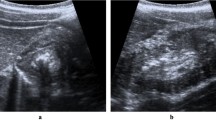Abstract
Background
Despite advances in non-invasive radiological techniques for the treatment of intussusception, management of the entity still remains exclusively surgical in many developing countries, including Ethiopia. Fluoroscopic units are rare or mostly dysfunctional. Ultrasound scanners are more commonly available. Ultrasound-guided hydrostatic reduction (USGHR) was recently introduced to the main referral hospital in Ethiopia, and subsequently has been adopted as the initial management option for intussusception.
Purpose
The aim of this study was to evaluate our experience with USGHR in Ethiopia and measure the impact on patient care.
Methods
A prospective study was conducted between July 2014 and August 2015 on all pediatric patients, with US-confirmed intussusception, at the Tikur Anbessa Specialized Teaching Hospital in Addis Ababa, Ethiopia. All patients, excluding those with signs of peritonitis, bowel ischemia, or symptoms lasting longer than 4 days, were selected to undergo USGHR.
Results
A total of 53 children were diagnosed with intussusception, confirmed via ultrasound. Following exclusion criteria, USGHR was attempted in 47 of the patients. Forty-one of the 47 patients (87.2%) had successful reduction, resulting in a 77% overall rate of successful non-operative management in all patients with intussusception.
Conclusion
The rate of operative reduction of intussusception decreased by 77% following the introduction of USGHR as the initial non-surgical intervention. Therefore, we believe USGHR should be fully implemented in our hospital, and recommend that this study serves as an example to other institutions in our country as well as in other developing countries facing similar challenges.

Similar content being viewed by others
References
del-Pozo G, Albillos JC, Tejedor D, Calero R, Rasero M, de-la-Calle U, López-Pacheco U (1999) Intussusception in children: current concepts in diagnosis and enema reduction. Radiographics 19(2):299–319
Daneman A, Navarro O (2004) Intussusception. Part 2: an update on the evolution of management. Pediatr Radiol 34(2):97–108
Ko HS, Schenk JP, Troger J, Rohrschneider WK (2007) Current radiological management of intussusception in children. Eur Radiol 17(9):2411–2421
Kim YG, Choi BI, Yeon KM et al (1982) Diagnosis and treatment of childhood intussusception using real-time ultrasonography and saline enema: preliminary report. J Korean Soc Med Ultrasound 1:66–70
Riebel TW, Nasir R, Weber K (1993) US-guided hydrostatic reduction of intussusception in children. Radiology 188(2):513–516
Reijnen JA, Festen C, van Roosmalen RP (1990) Intussusception: factors related to treatment. Arch Dis Child 65(8):871–873
Tareen F, Ryan S, Avanzini S, Pena V, Mc Laughlin D, Puri P (2011) Does the length of the history influence the outcome of pneumatic reduction of intussusception in children? Pediatr Surg Int 27(6):587–589
Wood SK, Kim JS, Suh SJ, Paik TW, Choi SO (1992) Childhood intussusception: US-guided hydrostatic reduction. Radiology 182(1):77–80
Betz BW, Hagedorn JE, Guikema JS, Banres CL (2013) Therapeutic enema for pediatric ileocolic intussusception: using a balloon catheter improves efficacy. Emerg Radiol 20:385–391
Lawal TA, Atalabi OM, Adekanmi AJ, Ogundoyin OO (2009) Factors influencing the practice of hydrostatic reduction of intussusception amongst radiologists in a developing country. West African Journal of Ultrasound 10:1–4
Meier DE, Coln CD, Rescorla FJ, OlaOlorun A, Tarpley JL (1996) Intussusception in children: international perspective. World J Surg 20(8):1035–1039
Hadidi AT, El Shal N (1999) Childhood intussusception: a comparative study of nonsurgical management. J Pediatr Surg 34(2):304–307
Mensah Y, Glover-Addy H, Etwire V, Appeadu-Mensah W, Twum M (2011) Ultrasound guided hydrostatic reduction of intussusception in children at Korle Bu Teaching Hospital: an initial experience. Ghana Med J 45(3):128–131
Nayak D, Jagdish S (2008) Ultrasound guided hydrostatic reduction of intussusception in children by saline enema: our experience. Indian J Surg 70(1):8–13
He N, Zhang S, Ye X, Zhu X, Zhao Z, Sui X (2014) Risk factors associated with failed sonographically guided saline hydrostatic intussusception reduction in children. J Ultrasound Med 33(9):1669–1675
Hernandez JA, Swischuk LE, Angel CA (2004) Emerg Radiol 10:323–326
Atalabi OM, Ogundoyin OO, Ogunlana DI, Onasanya OM, Lawal TA, Olarinoye AS (2007) Hydrostatic reduction of intussusception under ultrasound guidance: an initial experience in a developing country. Afr J Paediatr Surg 4(2):68–71
Tander B, Baskin D, Candan M, Basak M, Bankoglu M (2007) Ultrasound guided reduction of intussusception with saline and comparison with operative treatment. Ulus Travma Acil Cerrahi Derg 13(4):288–293
Bai YZ, Qu RB, Wang GD, Zhang KR, Li Y, Huang Y, Zhang ZB, Zhang SC, Zhang HL, Zhou X, Wang WL (2006) Ultrasound-guided hydrostatic reduction of intussusceptions by saline enema: a review of 5218 cases in 17 years. Am J Surg 192(3):273–275
Ghribi A, Sahil S, Sghairoun N, Fitouri F, Gasmi M, Hamzaoui M (2014) Recurrent intussusception in infants. Int J Clin Pediatr 3(4):105–107
Hsu WL, Lee HC, Yeung CY, Chan WT, Jiang CB, Sheu JC, Wang NL, Shih SL (2012) Recurrent intussusception: when should surgical intervention be performed? Pediatr Neonatol 53(5):300–303
Niramis R, Watanatittan S, Kruatrachue A, Anuntkosol M, Buranakitjaroen V, Rattanasuwan T, Wongtapradit L, Tongsin A (2010) Management of recurrent intussusception: nonoperative or operative reduction? J Pediatr Surg 45(11):2175–2180
Author information
Authors and Affiliations
Corresponding author
Ethics declarations
This was a cross-sectional prospective study, approved by the Institutional Review Board, performed over a 14-month period from July 2014 to August 2015. All parents or caretakers of the patients undergoing the procedure were informed about the procedure and requested to sign informed written consent in their local language.
Conflict of interest
The authors declare that they have no conflict of interest.
Rights and permissions
About this article
Cite this article
Wakjira, E., Sisay, S., Zember, J. et al. Implementing ultrasound-guided hydrostatic reduction of intussusception in a low-resource country in Sub-Saharan Africa: our initial experience in Ethiopia. Emerg Radiol 25, 1–6 (2018). https://doi.org/10.1007/s10140-017-1546-y
Received:
Accepted:
Published:
Issue Date:
DOI: https://doi.org/10.1007/s10140-017-1546-y




